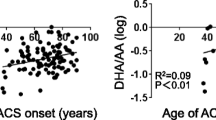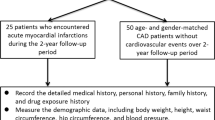Abstract
Objective
This study aimed at investigating the relationship among the eicosapentaenoic acid (EPA)/arachidonic acid (AA) ratio, the left ventricular (LV) structure and function in patients with diabetes.
Research design and methods
Inpatients with diabetes (n = 91) were included in the study. Serum fatty acid levels (EPA, AA, and docosahexaenoic acid) and lipid profiles were measured. The LV dimension and wall thickness were measured using echocardiography.
Results
The mean age was 56 ± 17 years, and 49 % were men. The average number of days per week with a fish-based diet was 4 ± 2. The mean EPA/AA ratio was 0.34 ± 0.18. Linear regression analysis identified no significant relationships between EPA/AA ratio and LV parameters. Setting the study-specific threshold value of the EPA/AA ratio group at 0.43, which indicates the highest value of EPA/AA ratio group calculated by quartiles, the higher group (EPA/AA ≥0.43) and the lower group (EPA/AA <0.43) were compared for LV parameters. Interventricular septal thickness and posterior wall thickness were significantly thinner in the higher EPA/AA ratio group than the lower group (p < 0.05, respectively). Left ventricular mass index was not significantly different between the groups. In multiple regression analysis, the association between the higher EPA/AA ratio group and LV wall thickness remained significant after adjustments for confounding variables (p = 0.01, p < 0.05, respectively).
Conclusions
A higher EPA/AA ratio was associated with reduced LV wall thickness. The EPA/AA ratio may play an important role in preventing LV wall thickness in patients with diabetes.

Similar content being viewed by others
References
Caterina RD. n-3 fatty acids in cardiovascular disease. N Engl J Med. 2011;364:2439–50.
Din JN, Newby DE, Flapan AD. Omega 3 fatty acids and cardiovascular disease-fishing for a natural treatment. BMJ. 2004;328:30–5.
Thie F, Garry JM, Yaqoob P, Rerkasem K, Williams J, Shearman CP, Gallagher PJ, Calder PC, Grimble RF. Association of n-3 polyunsaturated fatty acids with stability of atherosclerotic plaques: a randomized controlled trial. Lancet. 2003;361:477–85.
Leaf A, Kang JX, Xiao YF, Billman GE. Clinical prevention of sudden cardiac death by n-3 polyunsaturated fatty acids and mechanism of prevention of arrhythmias by n-3 fish oil. Circulation. 2003;107:2646–52.
Geleijnse JM, Giltay EJ, Grobbee DE, Donders AR, Kok FJ. Blood pressure response to fish oil supplementation: meta regression analysis of randomized trials. J Hypertens. 2002;20:1493–9.
Lee TH, Hoover RL, Williams JD, Sperling RI, Ravalese J 3rd, Spur BW, Robinson DR, Corey EJ, Lewis RA, Austen KF. Effect of dietary enrichment with eicosapentaenoic and docosahexaenoic acids on in vitro neutrophil and monocyte leukotorien generation and neutrophil function. N Eng J Med. 1985;312:1217–24.
Endres S, Ghorbani R, Kelley VE, Georgilis K, Lonnemann G, van der Meer JW, Cannon JG, Rogers TS, Klempner MS, Weber PC, Schaefer EJ, Wolff SM, Dinarello CA. The effect of dietary supplementation with n-3 polyunsaturated fatty acids on synthesis of interleukin-1 and tumor necrosis factor by mononuclear cells. N Eng J Med. 1989;320:265–71.
Marik PE, Varon J. Omega-3 dietary supplements and the risk of cardiovascular events: a systematic review. Clin Cardiol. 2009;32:365–72.
Matsuzaki M, Yokoyama M, Saito Y, Origasa H, Ichikawa Y, Oikawa S, Sakai J, Hishida H, Itakura H, Kita T, Kitabatake A, Nakaya N, Sakata T, Shimada K, Shirato K, Matsuzaka Y. Incremental effects of eicosapentaenoic acid on cardiovascular events in statin-treated patients with coronary artery disease -secondary prevention analysis from JELIS. Circ J. 2009;73:1283–90.
Oikawa S, Yokoyama M, Origasa H, Matsuzaki M, Matsuzawa Y, Saito Y, Ichikawa Y, Sasaki J, Hishida H, Itakura H, Kita T, Kitabatake A, Nakaya N, Sakata T, Shimada K, Shirato K. Suppressive effect of EPA on the incidence of coronary events in hypercholesterolemia with impaired glucose metabolism: sub-analysis of the Japan EPA lipid intervention study (JELIS). Atherosclerosis. 2009;206:535–9.
Seino Y, Nanjo K, Tajima N, Kadowaki T, Kashiwagi A, Araki E, Ito C, Inagaki N, Iwamoto Y, Kasuga M, Hanafusa T, Haneda M, Ueki K. Report of the Committee of the diagnostic criteria of diabetes mellitus: the Committee of the Japan Diabetes Society on the diagnostic criteria of diabetes mellitus. Diabetol Int. 2010;1:2–20.
Kashiwagi A, Kasuga M, Araki E, Oka Y, Hnafusa T, Ito H, Tominaga M, Oikawa S, Noda M, Kawamura T, Sanke T, Namba M, Hashiramoto M, Sasahara T, Nishio Y, Kuwa K, Ueki K, Takei I, Umemoto M, Murkami M, Yamakado M, Yatomi Y, Ohashi H, Committee on the Standardization of Diabetes Mellitus-Related Laboratory Testing of Japan Diabetes Society. International clinical harmonization of glycated hemoglobin in Japan: from Japan diabetes society to National Glycohemoglobin Standardization Program values. Diabetol Int. 2012;3:8–10.
Matsuo S, Imai E, Horio M, Yasuda Y, Tomita K, Nitta K, Yamagata K, Tomino Y, Yokoyama H, Hishida A. Collaborators developing the Japanese equation for GFR. Revised equations for estimated GFR from serum creatinine in Japan. Am J Kidney Dis. 2009;53:982–92.
Devereux RB, Reicheck N. Echocardiographic determination of left ventricular mass in man: anatomic validation of the method. Circulation. 1977;55:613–8.
Yano Y, Hoshide S, Tamaki N, Inokuchi T, Nagata M, Yokota N, Hidaka T, Kanemaru Y, Matsuda S, Kuwabara M, Shimada K, Kario K. Regional differences in hypertensive cardiovascular remodeling between fishing and farming communities in Japan. Am J Hypertens. 2011;24:437–43.
Duda MK, O’Shea KM, Tintinu A, Xu W, Khairallah RJ, Barrows BR, Chess DJ, Azimzadeh AM, Harris WS, Sharov VG, Sabbah HN, Stanley WC. Fish oil, but not flaxseed oil, decreases inflammation and prevents pressure overload-induced cardiac dysfunction. Cardiovasc Res. 2009;81:319–27.
Hunt SA, Abraham WT, Chin MH, Feldman AM, Francis GS, Ganiats TG, Jessup M, Konstam MA, Mancini DM, Michl K, Oates JA, Rahko PS, Silver MA, Stevenson LW, Yancy CW, American College of Cardiology Foundation, American Heart Association. 2009 focused update incorporated into the ACC/AHA, 2005 guidelines for the diagnosis and management of heart failure in adults, a report of the American College of Cardiology Foundation/American Heart Association task force on practice guidelines developed in collaboration with the international society for heart and lung transplantation. J Am Coll Cardiol. 2009;53:1–90.
Palmieri V, Tracy RP, Roman MJ, Liu JE, Best LG, Bella JN, Robbins DC, Howard BV, Devereux RB, Strong Heart Study. Relation of left ventricular hypertrophy to inflammation and albuminuria in adults with type 2 diabetes: the strong heart study. Diabetes Care. 2003;26:2764–969.
Romen MJ, Pickering TG, Schwartz JE, Pini R, Devereux RB. Association of carotid atherosclerosis and left ventricular hypertrophy. J Am Coll Cardiol. 1995;25:83–90.
Lindholm LH, Ibsen H, Dahlöf B, Devereux RB, Beevers G, de Faire U, Fyhrquist F, Julius S, Kjeldsen SE, Kristiansson K, Lederballe-Pedersen O, Nieminen MS, Omvik P, Oparil S, Wedel H, Aurup P, Edelman J, Snapinn S, LIFE Study Group. Cardiovascular morbidity and mortality in patients with diabetes in the Losartan intervention for endpoint reduction in hypertension study (LIFE): a randomised trial against atenolol. Lancet. 2002;359:1004–10.
Shoelson SE, Lee J, Goldfine AB. Inflammation and insulin resistance. J Clin Invest. 2006;116:1793–801.
Kuwahara F, Kai H, Tokuda K, Niiyama H, Tahara N, Kusaba K, Takemiya K, Jalalidin A, Koga M, Nagata T, Shibata R, Imaizumi T. Roles of intercellular adhesion molecule-1 in hypertensive cardiac remodeling. Hypertension. 2003;41:819–23.
Bozkurt B, Kribbs SB, Clubb FJ Jr, Michael LH, Didenko VV, Hornsby PJ, Seta Y, Oral H, Spinale FG, Mann DL. Pathophysiologically relevant concentrations of tumor necrosis factor-alpha promote progressive left ventricular dysfunction and remodeling in rats. Circulation. 1998;97:1382–91.
Masiha S, Sundström J, Lind L. Inflammatory markers are associated with left ventricular hypertrophy and diastolic dysfunction in a population-based sample of elderly men and women. J Hum Hypertens. 2013;27:13–7.
Bo S, Mandrile C, Milanesio N, Pagani A, Gentile L, Gambino R, Villois P, Ghinamo L, Canil S, Durazzo M, Cassader M, Cavallo-Perin P. Is left ventricular hypertrophy a low-level inflammatory state? A population-based cohort study. Nutr Metab Cardiovasc Dis. 2012;22:668–76.
Satoh N, Shimatsu A, Kotani K, Sakane N, Yamada K, Suganami T, Kuzuya H, Ogawa Y. Purified eicosapentaenoic acid reduces small dense LDL, remnant lipoprotein particles, and C-reactive protein in metabolic syndrome. Diabetes Care. 2007;30:144–6.
Moertl D, Hammer A, Steiner S, Hutuleac R, Vonbank K, Berger R. Dose-dependent effects of omega-3-polyunsaturated fatty acids on systolic left ventricular function, endothelial function, and markers of inflammation in chronic heart failure of nonischemic origin: a double-blind, placebo-controlled, 3-arm study. Am Heart J. 2011;161(915):e1–9.
James MJ, Gibson RA, Cleland LG. Dietary polyunsaturated fatty acids and inflammatory mediator production. Am J Clin Nutr. 2000;71:343S–8S.
Sirbu A, Stanca I, Copaescu C, Martin S, Albu A, Barbu C, Fica S. Association of serum adiponectin and IGF-I levels with parameters of cardiac remodeling in severely obese patients. J Endocrinol Invest. 2013;36:686–92.
Weyer C, Funahashi T, Tanaka S, Hotta K, Matsuzawa Y, Pratley RE, Tataranni PA. Hypoadiponectinea in obesity and type 2 diabetes: close association with insulin resistance and hyperinsulinemia. Endocrinol Med. 2001;86:1030–5.
Itoh M, Suganami T, Satoh N, Tanimoto-Koyama K, Yuan X, Tanaka M, Kawano H, Yano T, Aoe S, Takeya M, Shimatsu A, Kuzuya H, Kamei Y, Ogawa Y. Increased adiponectin secretion by highly purified eicosapentaenoic acid in rodent models of obesity and human obese subjects. Arterioscler Thromb Vasc Biol. 2007;27:1918–25.
Domei T, Yokoi H, Kuramitsu S, Soga Y, Arita T, Ando K, Shirai S, Kondo K, Sakai K, Goya M, Iwabuchi M, Ueeda M, Nobuyoshi M. Ratio of serum n-3 to n-6 polyunsaturated fatty acids and the incidence of major adverse cardiac events in patients undergoing percutaneous coronary intervention. Circ J. 2012;76:423–9.
Dolecek TA, Grandis G. Dietary polyunsaturated fatty acids and mortality in multiple risk factor intervention trial (MRFIT). World Rev Nutr Diet. 1991;66:205–16.
Kondo T, Ogawa K, Satake T, Kitazawa M, Taki K, Sugiyama S. Plasma-free eicosapentaenoic acid/arachidonic acid ratio: a possible new coronary risk factor. Clin Cardiol. 1986;9:413–6.
Okuyama H. High n-6 to n-3 ratio of dietary fatty acids rather than serum cholesterol as a major risk factor for coronary heart disease. Eur J Lipid Sci Technol. 2001;103:418–22.
Nakamura T, Azuma A, Kuribayashi T, Sugihara H, Okuda S, Nakagawa M. Serum fatty acid levels, dietary style and coronary heart disease in three neighbouring areas in Japan: the Kunihama study. Br J Nutr. 2003;89:267–72.
Yokoyama M, Origasa H, Matsuzaki M, Matsuzawa Y, Saito Y, Ishikawa Y, Oikawa S, Sasaki J, Hishida H, Itakura H, Kita T, Kitabatake A, Nakaya N, Sakata T, Shimada K, Shirato K. Japan EPA lipid intervention study (JELIS) Investigators. Effects of eicosapentaenoic acid on major coronary events in hypercholesterolaemic patients (JELIS): a randomized open-label, blinded endpoint analysis. Lancet. 2007;369:1090–8.
Conflict of interest
There were no relevant conflicts of interest to disclose in our study.
Author information
Authors and Affiliations
Corresponding author
About this article
Cite this article
Okamoto, K., Sato, A., Matsukawa, K. et al. Impact of eicosapentaenoic acid/arachidonic acid ratio on left ventricular structure in patients with diabetes. Diabetol Int 6, 46–54 (2015). https://doi.org/10.1007/s13340-014-0172-0
Received:
Accepted:
Published:
Issue Date:
DOI: https://doi.org/10.1007/s13340-014-0172-0




